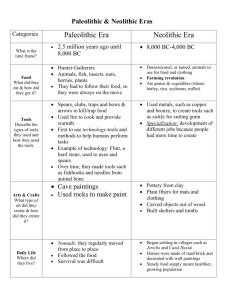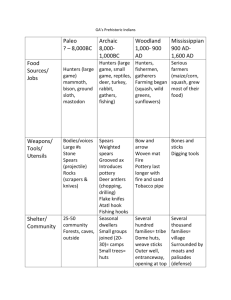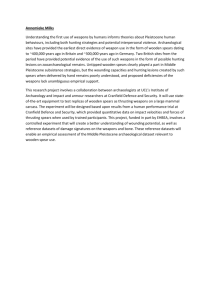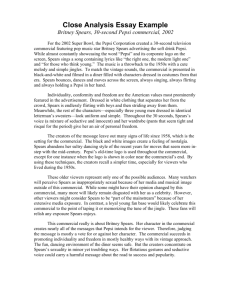A SPEARS: A Surface Ship Sonar Data Analysis and Reconstruction System
advertisement
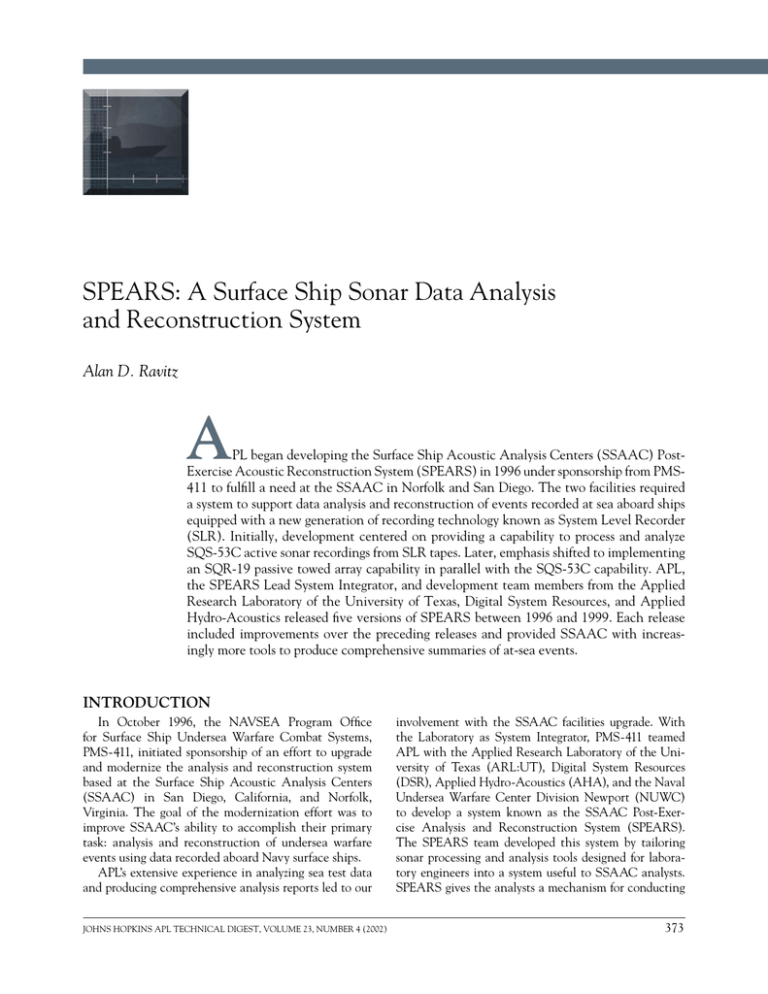
SPEARS SPEARS: A Surface Ship Sonar Data Analysis and Reconstruction System Alan D. Ravitz A PL began developing the Surface Ship Acoustic Analysis Centers (SSAAC) PostExercise Acoustic Reconstruction System (SPEARS) in 1996 under sponsorship from PMS411 to fulfill a need at the SSAAC in Norfolk and San Diego. The two facilities required a system to support data analysis and reconstruction of events recorded at sea aboard ships equipped with a new generation of recording technology known as System Level Recorder (SLR). Initially, development centered on providing a capability to process and analyze SQS-53C active sonar recordings from SLR tapes. Later, emphasis shifted to implementing an SQR-19 passive towed array capability in parallel with the SQS-53C capability. APL, the SPEARS Lead System Integrator, and development team members from the Applied Research Laboratory of the University of Texas, Digital System Resources, and Applied Hydro-Acoustics released five versions of SPEARS between 1996 and 1999. Each release included improvements over the preceding releases and provided SSAAC with increasingly more tools to produce comprehensive summaries of at-sea events. INTRODUCTION In October 1996, the NAVSEA Program Office for Surface Ship Undersea Warfare Combat Systems, PMS-411, initiated sponsorship of an effort to upgrade and modernize the analysis and reconstruction system based at the Surface Ship Acoustic Analysis Centers (SSAAC) in San Diego, California, and Norfolk, Virginia. The goal of the modernization effort was to improve SSAAC’s ability to accomplish their primary task: analysis and reconstruction of undersea warfare events using data recorded aboard Navy surface ships. APL’s extensive experience in analyzing sea test data and producing comprehensive analysis reports led to our JOHNS HOPKINS APL TECHNICAL DIGEST, VOLUME 23, NUMBER 4 (2002) involvement with the SSAAC facilities upgrade. With the Laboratory as System Integrator, PMS-411 teamed APL with the Applied Research Laboratory of the University of Texas (ARL:UT), Digital System Resources (DSR), Applied Hydro-Acoustics (AHA), and the Naval Undersea Warfare Center Division Newport (NUWC) to develop a system known as the SSAAC Post-Exercise Analysis and Reconstruction System (SPEARS). The SPEARS team developed this system by tailoring sonar processing and analysis tools designed for laboratory engineers into a system useful to SSAAC analysts. SPEARS gives the analysts a mechanism for conducting 373 A. D. RAVITZ their evaluation and producing a comprehensive final summary report quickly and efficiently. SPEARS evolved over four phases, and each successive phase released to SSAAC included improvements over previous phases. In this manner, the development team worked within the limited funding resources made available by PSM-411 and supplied SSAAC with new and useful capabilities over a period of several years. Furthermore, the phased development approach allowed SSAAC analysts the opportunity to heavily influence the functionality and design of each phase. APL has benefited enormously from being part of this effort. By leveraging the knowledge and experience acquired developing SPEARS, plus our knowledge of tactical sonar systems, we have extended SPEARS work into other programs. These include a data fusion research effort involving radar and sonar data, as well as a program involving real-time at-sea sonar data collection focused on developing advanced processing capabilities for the submarine community’s Advanced Processing Build/Acoustic Rapid Commercial Off-theShelf (COTS) Insertion (APB/ARCI) Program. PMS-411 PROJECTS AND THE ROLE OF SSAAC PMS-411 responsibilities extend across a broad spectrum of issues related to the AN/SQQ-89 Combat System including research and development, production, life-cycle maintenance, and Fleet training. A key part of these responsibilities is establishment of a mechanism for improving system and operator proficiency. To support this effort, PMS-411 sponsors several key related projects: • Tactical Active Sonar Acoustic Database, a repository of real-world and sea test data residing at NUWC. Among NUWC’s responsibilities is distributing data to the research community to support the development of future sonar systems. • Surface Ship Acoustic Analysis Proficiency Project, an infrastructure involving expert sonar analysts based at facilities established to train and evaluate the proficiency and performance of Fleet sonar operators using real-world data. • System Level Recorder (SLR), a system developed by PMS-411 to record AN/SQQ-89 sonar data. • SSAAC, facilities hosting expert sonar analysts capable of processing and analyzing data recorded during surface ship exercises and real-world encounters. When ships return pierside in Norfolk, the SLR tapes are forwarded to an SSAAC, which then processes the data recorded on the tapes and publishes post-exercise summary reports that include • Validations of submarine detections recorded by the shipboard operators 374 • Identification of submarine detections missed by the shipboard operators • Statistics concerning detections such as hold time (duration a detection was held), range (distance), and other important parameters that characterize the sonar system and operator performance The summary reports are distributed to key SSAAC customers including Navy commands, Fleet commanding officers, training centers, and laboratory research centers. Navy commands such as PMS-411 receive feedback from SSAAC covering the performance of the sonar systems. System performance measures indicate where PMS-411 should direct research and development activities to improve the sonar capabilities. For example, if SSAAC analysis reveals that the sonar operators had difficulty detecting and tracking slow moving contacts, PMS411 can direct the Navy laboratories to develop new displays, waveforms, or tactics to improve performance against slow contacts. Fleet commanding officers receive feedback on the performance of their sonar teams. Through detailed analysis of the at-sea events, SSAAC analysts can evaluate the sonar team’s ability to conduct anti-submarine warfare (ASW) operations, including submarine detection, submarine tracking, and weapon delivery. The Fleet also benefits from SSAAC analysis reports prior to deployment. SSAAC conducts predeployment briefs drawing on its analysis experience to educate the deploying sonar team on what to expect during ASW operations in the deployment area. In addition, training centers rely on SSAAC’s expertise to identify key snippets of real-world data for use in training sonar operators. Laboratory research centers (e.g., NUWC, ARL:UT, and APL) receive data from SSAAC to fuel the research and development efforts funded by sponsors such as PMS-411. ONGOING SONAR SYSTEM DEVELOPMENT PROGRAMS Beginning in FY2003, surface ship sonar systems are slated for a technology and capability refresh to the legacy SQQ-89 system in the form of (V)15 and A(V)15 upgrades. One component of the technology and capability refresh planned for these variants is the Echo Tracker Classifier (ETC), a processing system that automatically detects and tracks signals received by the ship’s active sonar. ETC is a fundamental component of several PMS-411 sonar programs under development. It provides signal processing, information processing, and automated tracking for planned upgrades to active sonar processing within the SQQ-89 variants, (V)15 and A(V)15. By using ETC processing for the signal processing component of SPEARS, PMS-411 puts a version of ETC in the JOHNS HOPKINS APL TECHNICAL DIGEST, VOLUME 23, NUMBER 4 (2002) SPEARS hands of sonar operators (i.e., SSAAC analysts) many years before the system appears in the Fleet. Similarly, for towed array passive sonar processing, PMS-411 funded integration of SPEARS and a version of the submarine community’s APB that supports the surface ship SQR-19 towed array, APB/SQR-19. APB/SQR-19 gives the SSAAC analysts advanced reconstruction and analysis capabilities using a system that will appear in the Fleet several years down the road. Specifically, PMS-411 negotiated an agreement with the Advanced Systems and Technology Office (ASTO) and PMS-425 to transition towed array processing technology from ATSO/PMS-425’s submarine APB/ ARCI Program to provide the processing for the multifunction towed array, the next-generation towed array slated to replace the SQR-19 aboard (V)15/A(V)15equipped ships. The APB/ARCI Program is a system development project that infuses improved sonar processing capability into the submarine Fleet on a more frequent basis than the traditional 5- to 15-year cycle. As a first step in adapting the APB systems developed for the submarine towed arrays to the surface ship tactical environment, PMS-411 sponsored APL and DSR to modify an APB/TB-23 system to create the APB/SQR-19. APB/SQR-19 now resides at SSAAC and, via SPEARS, SSAAC analysts are gaining experience with the advanced processing slated to appear in the surface ship Fleet in the future. In summary, PMS-411’s goal in combining ETC, APB/SQR-19, and SPEARS was based mainly on two factors: (1) placing advanced technology in the hands of sonar analysts well before the systems are slated for Fleet introduction to gain the opportunity for early constructive feedback on system performance, and (2) cost savings—the SPEARS development team did not need to develop new processing capabilities from scratch to support analysis and reconstruction; instead, they could rely on the well-established development and configuration management aspects of two high-profile Navy programs (ETC and APB). SYSTEM LEVEL RECORDER: “THE ENABLER” The SLR is fundamental to enabling SSAAC to perform their functions. Without the SLR, the data available for post-exercise analysis and reconstruction would be severely limited, thus hindering the ability to improve operator performance or the performance and capabilities of future sonar systems. SLR version 3.0 (SLR 3.0) is installed on the Navy’s destroyers and cruisers. SLR 3.0 employs a Metrum tape recorder which uses T-120 or T-160 tapes commonly found in commercial VCRs. Aboard ship, the SLR is networked with the SQQ-89 Combat System and records acoustic and nonacoustic data from the JOHNS HOPKINS APL TECHNICAL DIGEST, VOLUME 23, NUMBER 4 (2002) SQQ-28, SQR-19, and SQS-53C. The SQS-53C data stream recorded on tape has an extensive amount of information associated with it, including acoustic data, ping date/time, waveform/mode type, range gates, and detection data (“tags”) as well as limited environmental information such as acoustic speed of sound and bottom depth. The SQR-19 data stream includes the towed array’s acoustic data, array heading, array depth, and array temperature. The SQQ-28 data include similar information for sonobuoys, although SPEARS does not support sonobuoy processing. A key attribute of data recorded on SLR tapes is that when replayed, the data from each of the three sonar systems can be time-aligned for post-exercise reconstruction of the at-sea events. Time alignment of the data allows the analyst to correlate detections and tracks of underwater contacts across the three sensors, potentially leading to a clearer view of the undersea environment than available with any one sensor alone. SPEARS is designed to facilitate concurrent analysis of SQS-53C and SQR-19 data, thereby giving the SSAAC analysts the tools needed to produce a comprehensive and quantitative final summary report. SSAAC HIGH-LEVEL REQUIREMENTS Informal discussions with SSAAC personnel, rather than traditional formal procedures normally followed by most defense acquisition system development efforts, guided the requirements for SPEARS functionality and capability. Through these informal discussions, several SSAAC high-level requirements emerged: • A reconstruction/analysis system for data recorded on SLR tapes during controlled exercises and realworld encounters • A method of information integration from a wide range of sensors including all three SQQ-89 sonars, navigation data, and other sources • An ability to visualize data exactly as they were displayed to the at-sea operator • An ability to visualize data in ways that exceeded how they were displayed to the shipboard operator; using advanced analysis tools, the SSAAC analysts could dig into the data recorded at sea to get a highly detailed view of the underwater scene • Processing stream tap-points for information extraction to support analysis and reconstruction • A method to facilitate data distribution to facilities such as APL, ARL:UT, and NUWC SPEARS was designed to meet these requirements. SPEARS General Overview SPEARS forms an umbrella environment that interfaces legacy systems, advanced systems, and 375 A. D. RAVITZ engineering tools into a postexercise analysis and reconstruction system for SSAAC analysts (Fig. 1). SPEARS treats these elements as “black boxes” with data tap-points, where data are extracted and stored on disk for retrieval during analysis. SPEARS provides graphical user interfaces (GUIs) to allow the analysts to initialize processing parameters, monitor processing status, and simplify system maintenance procedures. The system also enables SSAAC to archive and export data in a well-defined format for distribution to NUWC, APL, ARL:UT, and other involved organizations. One Level Deeper User interfaces Report generation Screen capture Post-exercise contacts Processing Initiate Monitor Halt Disk/data utilities Archive Purge Restore Usage Import data Export data Analysis Database Engineering analysis tools Event summary Geographic display SQS-53C active and passive Legacy display Advanced active display Advanced developmental display APB/SQR-19 Advanced developmental display SQS-53C active and passive Legacy processing string ETC 2.0 Advanced developmental processing APB/SQR-19 Advanced developmental processing The basis of the SPEARS software system is a conglomeration of stand-alone applications that have SQR-19, SQS-53C SLR system been woven together to produce an Legacy systems interface analysis and reconstruction system. These applications include those Figure 1. Overview of the legacy systems, advanced systems, and engineering tools that make up SPEARS. shown in Fig. 1 and range from processing (ETC, APB/SQR-19, advanced active sonar display preprocessing) to disk/data management (archive, restore, to summarize at-sea events. SPEARS saves the WAV purge, import/export data). GUIs create an infrastrucfiles in a directory specifically meant to retain audio files ture that isolates the users from the computer’s operatassociated with the particular SLR tapes under analysis. ing system and allows them to conduct processing and Post-Exercise Contacts analysis without having to be computer experts. While conducting a thorough analysis of the acousThe following sections describe SPEARS features tic data, SSAAC analysts need a mechanism for noting and interfaces. detections of submarines and other objects they observe in the data. SPEARS includes a “post-exercise contact” Screen Captures tool for this purpose. For example, an SQS-53C postTo enhance the quality of the final reports produced exercise contact might include date/time, range, bearby SSAAC, SPEARS gives the SSAAC analyst a clicking, Doppler, signal-to-noise ratio, and classification and-point mechanism for making pictures of each information (e.g., “POSSUB 1,” “POSSUB 2,” etc.). analysis tool. The files are saved in standard formats This information is automatically logged to the SPEARS (e.g., GIF, PS) in a directory specifically meant to retain Analysis Database (discussed below) by pointing and screen captures associated with the particular SLR tapes clicking the mouse cursor on the SPEARS acoustic analunder analysis. To prepare their final reports, the anaysis displays. Post-exercise contact information can be lysts simply import these files into word processing or combined with other information such as “tags,” which presentation software for annotation and narration of are detections marked by the at-sea sonar operator during the at-sea events. the actual event and recorded on SLR tape. Comparing tags with post-exercise contacts helps Audio Snippets the SSAAC analysts determine whether the at-sea operator detected an actual target or some other underSSAAC analysts can also save short segments of water object or nontarget. SPEARS saves both tags and active sonar audio data to WAV files, which can be post-exercise contacts in a directory specifically designed hyperlinked to screen captures created by the analysts. to retain tags and post-exercise contacts associated with Combining these data enhances the quality of the final the particular SLR tapes under analysis. report and improves the ability of the SSAAC analysts 376 JOHNS HOPKINS APL TECHNICAL DIGEST, VOLUME 23, NUMBER 4 (2002) SPEARS Geographic Display SPEARS interfaces with APL’s geographic (GEO) display and represents a key analysis and reconstruction feature for the SSAAC analysts (as well as a feature not available from the legacy system for the shipboard operator). The GEO display (Fig. 2) uses nonacoustic information from the SLR tape to plot symbols corresponding to the location of the ship (shown in blue in the figure) at the instant the SQS-53C transmission occurred. The SLR tape does not include latitude and longitude information, so the track data are computed by dead reckoning using information that is included on the SLR tape: the ship’s heading, speed, and transmit (ping) times. Unfortunately, unless the SQS-53C is pinging, the ship’s heading and speed are not included on the SLR tape and, under these circumstances, the GEO shows gaps in the ship’s track. The GEO display allows the analysts to • Overlay various symbols atop it to enhance the reconstruction and analysis process • Overlay time stamps at selectable intervals along the track, baffle indicators to identify areas where detections may be weak, and surface duct (SD) and variable depression (VD) zone sector settings to indicate areas where stronger detections may appear • Display bathymetric contour information on the GEO display if latitude and longitude data are available • Plot symbols corresponding to the geographic location of post-exercise contacts and tags • Choose from a wide range of symbol shapes (circles, squares, diamonds, etc.) and colors to distinguish one post-exercise contact or tag from another Surface duct mode coverage area Target track and “current” location SLR-equipped ship track SLR-equipped ship “current” location Variable depression mode coverage area Figure 2. Example of a GEO display. JOHNS HOPKINS APL TECHNICAL DIGEST, VOLUME 23, NUMBER 4 (2002) The GEO display in Fig. 2 shows the track for the SLR-equipped surface ship and the track of a target and demonstrates how the SSAAC analysts use SPEARS to visualize the data recorded on the SLR tapes. As mentioned above, the SLR tape does not include the latitude and longitude information of the SLR-equipped ship, nor does it include the target unit’s navigation data. Instead, SSAAC receives track data for target platforms following data collections conducted among friendly assets such as planned naval exercises. SPEARS includes an import mechanism that enables the SSAAC analysts to download the track data for the target(s) and display them on the GEO as shown here. By using the computer’s mouse button, the SPEARS user can highlight a segment of the track and obtain information about the time period corresponding to that track position as shown in the cursor readout in Fig. 2. Using the time/date functions window, the SPEARS user can rapidly move through large segments of data to observe how the relative position of the SLR-equipped ship varies with the target platform’s location. In the example shown in Fig. 2, at the location highlighted by the SPEARS operator, the target platform is on the extreme fringe of the SD mode coverage area but well inside the VD mode coverage area. The SSAAC analyst would use this information to hone in on the VD mode acoustic data to look for the target. Event Summary Display Features SPEARS interfaces with APL’s event summary display (ESD), which includes two subfunctions: time line plotting and histogram plotting. ESD time lines enable the SSAAC analysts to display, as a function of time, nonacoustic information extracted from SLR tapes and post-exercise contact data. These time lines give the analysts a perspective of important factors that transpired at sea as well as insight into which time periods could offer better value in terms of reconstructing the at-sea events. For example, if the focus of the analysis and reconstruction for a particular analysis effort is the detection and tracking performance of VD waveforms, then the analysts will plot a time line of the waveforms used during the at-sea events to look for periods of VD transmission. Here, periods without VD transmissions would be given lower priority. This example highlights how a SSAAC analyst can exploit SPEARS analysis tools to focus the analysis and reconstruction activities in order to expediently and comprehensively summarize the at-sea event. ESD histograms offer another perspective of the atsea events and allow SSAAC analysts to conduct a much more quantitative analysis summary compared with their previous capabilities. As an example of the utility of the ESD histograms, the SSAAC analysts might choose to display the distribution of three parameters: the speed of 377 A. D. RAVITZ the SLR-equipped ship, the range between the SLR-equipped ship and the target, and the relative bearing between the SLR-equipped ship and the target. Each of these parameters helps to summarize the at-sea events. Knowing the speed distribution helps because, generally, faster speeds decrease the performance of the sonar system. Knowing the range between the two platforms determines the detection capabilities of the SLR-equipped ship. The relative bearing distribution helps to determine if the target is located in the “baffle” region of the SQS-53C—a bearing sector spanning several degrees surrounding the stern where SQS-53C performance is diminished. Combining all the ESD histograms gives the SSAAC analyst insight into why the SLR-equipped ship was or was not able to detect and track the target. SQS-53C Active and Passive Legacy Display SPEARS interfaces with ARL: UT’s emulations of the legacy SQS-53C displays used aboard ship. APL integrated these displays into SPEARS to offer the SSAAC analysts a view of the data recorded at sea as presented to the shipboard legacy system operator. The analysts can recall acoustic data from the SPEARS Analysis Database at faster than real time and can use the SPEARS screen capture utility described above to store images of the emulation displays. (a) (b) Figure 3. Advanced active displays in (a) SD-CP (coherent pulse) mode and (b) VD-CW (continuous wave) mode. Advanced Active Sonar Displays SPEARS also interfaces with APL’s advanced active sonar displays (Fig. 3), which offer the SSAAC analysts a large set of tools for acoustic reconstruction and analysis. Analysts employ these advanced active sonar displays to visualize data processed through active and passive processing algorithms. The data are displayed in a manner that gives greater insight into the acoustic scene present at sea compared to the SQS-53C active and passive legacy display emulation and to the actual shipboard legacy equipment. 378 Among the acoustic analysis tools provided by the advanced active sonar displays are • B scans; A scans; and combined B scan, CW, and range/Doppler (“postage stamp”) displays with Selectable color scales (gray, blue, green) Audio playback (option to save snippet as WAV file) SQS-53C post-exercise contact creation Adjustable range scale JOHNS HOPKINS APL TECHNICAL DIGEST, VOLUME 23, NUMBER 4 (2002) SPEARS 6- or 12-ping history Scan range-rate cursor • Overlays with Ground truth navigation data for target platforms or other vessels if available SQS-53C post-exercise contacts • Integration with ESD and GEO The advanced active sonar display shown in Fig. 3a is an example of a 72-beam, 6-ping history, SD mode coherent pulse B scan. A B scan displays acoustic data in three dimensions: range, beam, and ping history. Sonar operators look for patterns, such as the one highlighted in the green cursor box in Fig. 3a, to identify target detections. All of the information shown in Fig. 3 is extracted from the SLR tape and displayed to help the SSAAC analyst conduct the acoustic search. Using the display controls located in the lower right-hand corner of the figure, the analyst quickly moves through many hours of data at a rate much faster than real time to identify detection periods. As discussed earlier, the analyst uses other SPEARS tools such as the post-exercise contact function, screen capture function, and audio snippet capture tool to store information about detections and then recall this information during preparation of the final report describing the at-sea events. Figure 3b is another example of an acoustic display included in the advanced active sonar display component of SPEARS. This CW display is the combined postage stamp display noted above. Surface sonar operators are trained to use the B scan format to find detections. Unfortunately, B scans eliminate Doppler information and, since Doppler can be an important clue that distinguishes a target from clutter (or nontarget), sonar operators can miss detections when using B scan displays. To meet the SSAAC analyst’s requirement of visualizing data in ways that exceed how they are displayed to the shipboard operator, the APL postage stamp display presents the CW data with Doppler information, thus enabling the SSAAC analyst to potentially find detections that the shipboard operator may have missed because the Doppler was not presented to the shipboard operator using the legacy SQS-53C sonar displays. APB/SQR-19 SPEARS interfaces with the APB/SQR-19 residing at SSAAC. APB/SQR-19 provides passive narrowband and broadband displays with a wide range of display options that offer access to the high-resolution processing conducted by the APB/SQR-19 towed array passive sonar processing string. As part of the effort by PMS-425 and ASTO to push the state of the art in passive sonar processing and display, highly experienced submarine sonar operators designed both the narrowband and broadband displays. Like the advanced active sonar displays JOHNS HOPKINS APL TECHNICAL DIGEST, VOLUME 23, NUMBER 4 (2002) associated with SPEARS, APB/SQR-19 offers SSAAC analysts superior processing and displays compared with the capabilities offered to the shipboard analysts by the current legacy system installed in the Fleet. Analysis Database Structure The design of the SPEARS Analysis Database was driven primarily by the need to minimize the time between the arrival of the new tapes at SSAAC and the distribution of a final report summarizing the events that transpired at sea. Meeting this requirement affected the type of hardware used to host SPEARS and heavily influenced the software design of the SPEARS Analysis Database. With respect to hardware, data from the SQS-53C and SQR-19 are stored on separate redundant-array-of-independent drive (RAID) systems that provide extremely fast input/output, thus maximizing data throughput capability. With respect to the software design of the SPEARS Analysis Database, speed and efficiency of input/output operations are maximized by a design that combines features of the Unix file system and an organization of data files for fast access and data retrieval. To understand the design of the Analysis Database, it must first be recognized that SSAAC analysts typically organize their analysis tasks according to the following key information: exercise identifier (ID; e.g., SHAREM 131), platform ID (e.g., USS Laboon [DDG 58]), sensor (e.g., SQS-53C or SQR-19), and date/time (i.e., recording or “ocean” time). Accordingly, the SPEARS analysis tools are designed to allow the analysts to specify which exercise ID, platform ID, sensor, and date/time they are interested in and then specifically what data they are interested in analyzing. For example, the analyst might specify the following request: • • • • • Exercise ID: SHAREM 131 Platform ID: USS Laboon Sensor: SQS-53C Date/time: 04-August-2000, 00:00:00–23:59:59 Data: VD mode, CP acoustic data on a 20-kyd range scale When the analyst requests the data in this manner, the analysis tools query the Analysis Database for the necessary information. The design of the Analysis Database is key to expediently searching and retrieving the requested information to satisfy the analyst’s query. Two features are fundamental: (1) Data are organized at the top level according to exercise ID; one Unix file system directory is created for each exercise ID. (2) Under each exercise ID, a directory is created for each platform ID for which the analyst will process and analyze data recorded on SLR tape. Since one exercise may involve multiple SLRequipped ships, the analyst can specify any number of platform IDs under an exercise. 379 A. D. RAVITZ Figure 4 illustrates this directory hierarchy. Exercise IDs are the highest level, with platform IDs below. In computer science language, the combination of an exercise ID and platform ID is a “primary key” into the Analysis Database and a unique identifier for a set of data. In this manner, for example, if Laboon participated in SHAREM 131 and SHAREM 130, the data for each would be organized under two unique directory structures called SHAREM131/LABOON and SHAREM130/LABOON, respectively. Under each exercise ID/platform ID directory, additional subdirectories exist. At the level just below platform ID, the data are divided into subdirectories based on sensor. This entire directory structure forms an organized, standardized process for data storage that allows the SPEARS analysts to easily retrieve information and compile an analysis report. As indicated in Fig. 4, SPEARS stores two additional files, located under the SQS-53C and SQR-19 subdirectory structures. These two files, called SQS-53CList and SQR-19List, are the heart of the Analysis Database for the advanced active, GEO, and ESD displays described earlier. Although the files are named differently and contain different data, their structure—which enables fast data search and retrieval—is very similar. time. SPEARS builds these lists independently as data from each sensor’s data stream reach the final stages of processing. For SQS-53C data, the SQS-53CList is created as the display-ready acoustic data files, or “megafiles,” are created. Each SQS-53C ping creates a new date/time entry into the SQS-53CList. SPEARS updates the SQS-53CList each time a new SQS-53C ping occurs by adding a new list entry. For SQR-19 data, the SQR19List is created as display-ready APB files are created. SPEARS adds a new entry to SQR-19List four times a second, which is the rate at which the SQR-19 outputs nonacoustic information. In computer science language, both SQS-53CList and SQR-19List are types of indexed, linked lists. This type of file structure is known to offer several key attributes including fast insertion of new data samples and fast and efficient retrieval of data requested by a user. Efficiency in this context refers to computer resources required to perform searches, updates, insertions, deletions, and other database functions. For the SPEARS design, computer resources are kept limited owing to the streamlined organization of the Analysis Database along the lines of an exercise ID, platform ID, and sensor as described above. One more key attribute of the SPEARS Analysis Database design, and the design of the SPEARS analysis SQS-53CList and SQR-19List Structure: tools that interface with the Analysis Database, is that A Conceptual Description multiple SSAAC analysts can concurrently conduct analysis and reconstruction of SQS-53C and SQR-19 As their names imply, SQS-53CList and SQR-19List data. This feature maximizes both human and comare lists of information organized and sorted by date and puter resources, thus minimizing the turnaround time between tapes SQS-53C active emulation arriving at SSAAC and distribution Analysis of a final report summarizing events Database SQS-53C active emulation that transpired at sea. SQS-53C passive emulation Exercise ID SQS-53C screen captures SQS-53C post-exercise contacts (active) Platform ID SQS-53C advanced active Mega-file: Ping 04-August-2000 11:34:40 Platform ID Mega-file: Ping 04-August-2000 11:35:20 • • • Mega-file: Ping 04-August-2000 23:35:20 Platform ID SQS-53CList SQR-19 Exercise ID SQR-19 screen captures SQR-19 post-exercise contacts SQR-19 display-ready files (APB/SQR-19) Exercise ID SQR-19List Figure 4. Structure of the Analysis Database. 380 SPEARS DEVELOPMENT TEAM As noted previously, several different organizations contributed to the development of SPEARS as it evolved from its inception in 1996 to the present. APL participated as System Integrator and also contributed by developing the advanced active sonar displays. As System Integrator, APL coordinated with each of the development team members with respect to designing interprocess interfaces, GUIs, and other aspects of the systems design. Drawing on a long history of experience with the SQS-53C and recent involvement with (V)15 and DD 21 development, ARL:UT played a key role in transitioning JOHNS HOPKINS APL TECHNICAL DIGEST, VOLUME 23, NUMBER 4 (2002) SPEARS new capabilities under the SPEARS umbrella. Specifically, ARL:UT supported transition of SQS-53C legacy (active and passive) processing as well as ETC 2.0 into SPEARS. DSR joined the team to add SQR-19 processing to SPEARS. DSR has been at the center of PMS-425 and ASTO efforts to develop advanced towed array processing for submarines in the ARCI Program. DSR adapted the APB, the computer system which functions as a prototype for ARCI systems that are ultimately installed on submarines, to handle the SQR-19 towed array found on SLR-equipped ships. By integrating APB under the SPEARS umbrella and providing this capability to SSAAC, PMS-411 allows the surface ship community to take advantage of advanced sonar processing developed by the submarine community. AHA also joined the team to help transition SQR-19 processing into SPEARS. Specifically, AHA developed a VME-based computer system that sits between the SLR playback system and APB. This computer system extracts SQR-19 data from the SLR fiber-distributed data interface (FDDI), beamforms the data, and passes the beamformed data to APB. NUWC was responsible for development of the SLR as well as installation and life-cycle maintenance of the equipment aboard ships and at SSAAC. DEVELOPMENT STRATEGY AND PROGRESS As illustrated in Fig. 5, SPEARS development progressed in stages starting in late 1996 and followed an evolutionary path to reach today’s capabilities. Phase 0 provided a rudimentary capability to the SSAAC analysts in the form of a MacIntosh-based processing system with data fed from 53C-formatted tapes, the predecessor of the SLR tape format. Although this system enabled some measure of SQS-53C analysis and reconstruction, the processing system did not give SSAAC the ability to process SLR-based recordings. Further, since 53Cformatted tapes are not readily produced during Fleet exercises—the focus of SSAAC’s work—only a limited data set could be analyzed by using SPEARS Phase 0. Following the installation of SLR playback units at SSAAC Norfolk and San Diego, the SPEARS development team released the Phase 1B system, which included a host of new analysis and processing tools including advanced active sonar displays, event summary time lines, and other features. The major limitation of Phase 1B was that the hardware platform did not possess the throughput/bandwidth required to process directly from SLR tape through the entire processing chain. The SPEARS Phase 2 and 3 systems supplied bug fixes and some new features. Phase 3 also included additional hardware that enabled the SSAAC analysts to process directly from SLR tape through the entire processing chain. This significantly improved the efficiency of the SSAAC analysts in terms of being able to quickly process a set of tapes and produce a comprehensive analysis report of the events recorded at sea. SPEARS Phase 3.1 enabled SSAAC analysts to concurrently process both SQS-53C and SQR-19 data from SLR tape. Along with additional hardware to support the concurrent processing, Phase 3.1 offered more analysis and reconstruction tools including statistical event summary plotting (histograms and scatter plots) and methods for combining SQS-53C active and SQR19 passive information. These capabilities offer the SSAAC analysts the tools necessary to comprehensively Feb 2000 APB/SQR-19 Updated analysis tools Sep 1999 Updated analysis tools Direct SLR processing Phase 3.1 Updated 53C active processing SQR-19 beamformer/APB processing/displays Enhanced report generation tools Feb 1998 Updated analysis tools Aug 1997 Initial SLR-based support Phase 3 Updated 53C active processing 53C ship display emulation (active/passive) Enhanced report generation tools Jan 1997 SLR installed Dec 1996 Initial 53C support Phase 2 APL delivers updated active advanced analysis tools APL and ARL support report creation, integrate real-time ETC 2.0 Phase IB ARL transitions initial ETC 2.0 APL delivers initial advanced active tools APL procures, delivers hardware to Norfolk and San Diego Phase 1A NUWC integrates SLR components with existing components at SSAAC Phase 0 ARL:UT delivers prototype processing and analysis displays Figure 5. SPEARS development time line. JOHNS HOPKINS APL TECHNICAL DIGEST, VOLUME 23, NUMBER 4 (2002) 381 A. D. RAVITZ Coaxial Ethernet Twisted pair Ethernet Printers and PCs Switch 24 port, full-duplex SQR-19 RAID 10 ⫻ 18 GB SLR ssaac-DP RAID 10 ⫻ 9 GB Tape drives SQS-53C RAID 8 ⫻ 18 GB UPS ssaac-53C UPS SQR-19 data UPS ssaac-19 and quantitatively summarize the recorded events. The SPEARS hardware configuration has evolved into the system illustrated in Fig. 6. SPEARS equipment occupies the two full-height 19-in. racks to the left and right of the SLR rack. SQS-53C processing is hosted on the Sun Enterprise 3000 (E3000). SQR-19 processing is hosted in the SQR-19 beamformer (VME-based) and the Sun Enterprise 4500, which runs APB/SQR-19. Each Sun computer hosts tape drives for archiving data and RAID systems for storing display-ready data for SQS-53C and SQR-19 processing. The computers are networked via a fullduplex Ethernet switch. UPS ssaac-DP Tape drives Audio speakers ssaac-19 Dual monitors Enterprise 4500 8 ⫻ 337, 4 GB SQR-19 beamformer (VME) ssaac-53C Single monitor Enterprise 4 ⫻ 337, 2 GB RIU ssaac-DP Dual monitors Enterprise E3000 2 ⫻ 250, 1 GB FDDI (Signal LAN) ONGOING AND FUTURE WORK Figure 6. Phase 3.1 hardware configuration (DP = display process, RIU = Recorder Interface Unit, UPS = uninterrupted power supply). APL has transitioned SPEARS into a maintenance phase. The Laboratory responds to questions and calls for assistance from SSAAC regarding SPEARS. Future SPEARS upgrades depend on available funding from PMS-411. APL used SPEARS to identify detections of submarines and surface ships in data sets collected to support two efforts: Integrated Undersea Warfare-21st Century (IUWS-21) and Integrated Anti-Submarine Warfare (IASW-21). APL also adapted SPEARS to provide data collection and analysis and reconstruction capabilities in support of PMS-425 and ASTO’s APB/ARCI Program. This adapted system, the ARCI engineering workstation (AEW), interfaces with APB and ARCI tactical systems for real-time data analysis and reconstruction aboard ARCI-equipped submarines. AEW uses modified versions of ESD, GEO, and Analysis Database design. The range/Doppler postage stamp display, which APL transitioned into SPEARS early in the system’s development, has been selected for inclusion in the future SQQ-89(V)15 surface ship sonar system scheduled for Fleet introduction several years from now. Furthermore, the APB/SQR-19 capabilities included in SPEARS provide a mechanism for getting feedback from surface ship sonar analysts several years before APB/SQR-19 is introduced Fleet-wide. ACKNOWLEDGMENTS: The development and continued maintenance of SPEARS would not have been possible without the efforts of numerous people. Deanna M. Green (APL) provided the software development skills that were critical to the successful development of SPEARS; her expertise led to a product that was delivered on time and on budget and was well received by SSAAC. Chad A. Mullinix (APL) also provided essential support to the development of SPEARS. Other key contributors from APL included Hilary L. Hershey, Michael J. Pekala, and David C. Hecht. P. D. Hartman, John C. Stapleton, and Jon R. Berry provided key program management support and guidance from APL. Dean Teffer (ARL: UT) provided key technical guidance and software development expertise focused on the integration of important SPEARS SQS-53C components. R. Murphy (DSR) and Peter Nulty (AHA) supplied support for development and integration of the APB/SQR-19 processing component of SPEARS. And finally, the SPEARS development team is indebted to the patience, guidance, and support of Wayne Beers (PMS-411) and the entire SSAAC staff. THE AUTHOR ALAN D. RAVITZ has been a member of the Signal and Information Processing Group of APL’s Submarine Technology Department (now the National Security Technology Department) since 1989. His sonar system engineering experience extends across surface, air, and submarine active and passive systems. He holds a B.S. in biomedical engineering (1987) from The Johns Hopkins University and an M.S. in electrical engineering (1989) from the University of Miami. His e-mail address is alan.ravitz@jhuapl.edu. 382 JOHNS HOPKINS APL TECHNICAL DIGEST, VOLUME 23, NUMBER 4 (2002)
